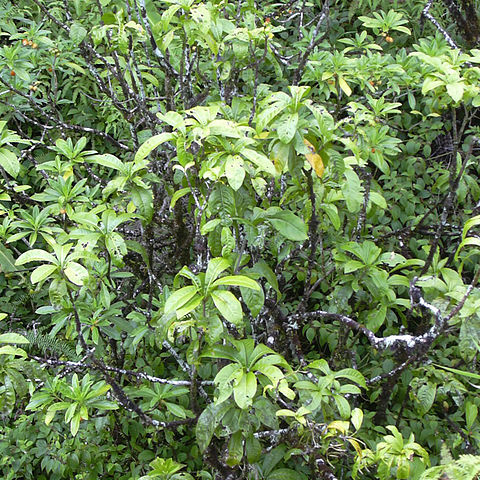Trees 4-20(-28) m, tomentose or glabrous; branches unarmed. Petiole 1-2.5 cm; leaf blade black-brown when dry, elliptic, oblong, or ovate-lanceolate, 10-20 × 4.5-8 cm, papery, glabrous, lateral veins 8-10 pairs, base broad cuneate, apex acuminate or slightly obtuse. Cymes terminal, paniculate, 5-12 cm. Flowers polygamous. Pedicel 1.5-6 mm, with 1-3 bracteoles near base. Perianth tube white, campanulate, 5-7 mm, with brown hairs, apex 5-lobed. Stamens 7-10, slightly exserted; filaments unequal, base united in a ring; anthers subglobose. Ovary oblong, upper acuminate. Style slender; stigma fimbriate, slightly exserted. Fruit subterete, slightly curved, 2.5-4 cm × 6-7 mm, 5-ribbed, smooth, glutinous; carpopodium thick, ca. 1 cm, with spreading persistent perianth at apex. Fl. and fr. autumn-winter.
Shrub or tree to 28 m high, unarmed. Leaves opposite, sometimes conferted towards the end of the twigs or in pseudowhorls, ovate-to elliptic-oblong, (6.5-)9-23(-31) by (3-)4-11(-13) cm; base acute to rounded; top acute to rounded; petiole ½-4 cm. Inflorescence terminal, branched, consisting of many-flowered umbels 3-9 cm through, puberulous or glabrous; peduncle 3.5-4 cm. Flowers bisexual or unisexual; pedicel 1.5-6 mm with 1-3 small bracteoles at the base or higher. Perianth 2.5-7 mm long, campanulate. Stamens 6-14, exserted to 4 mm. Stigma fimbriate; in the female flowers exserted for c. 1 mm and in the bisexual flowers c. 1.5 mm. Anthocarp elongate, 2-4 by 0.3-0.35 cm, with 5 viscid ribs; pedicel 0.7-1.5 cm. Seed 17-20 by 2 mm.
A shrub or small tree. It grows 5-15 m high. The trunk is 30 cm across. It is branched near the base. The leaves are alternate or opposite and in clusters. The leaf blade is oval and 6-20 cm long and 4-10 cm wide. They are soft. The leaf stalk is 2-5 cm long. The flowers are small and very fragrant. They contain both sexes. The fruit are 2-5 cm long and have ribs. They are sticky.


